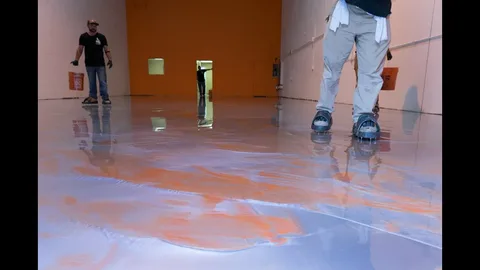A strong, lasting epoxy floor starts long before the first coat touches the concrete. The durability and visual appeal of epoxy flooring in Huntsville AL depend on how well each bonding step is handled. Every surface preparation method, chemical mix, and timing decision determines whether the coating will stay smooth and secure for years.
Surface Grinding Methods That Open Concrete Pores for Stronger Adhesion
Concrete grinding is one of the most effective ways to prepare a garage or workshop floor before applying epoxy. Diamond grinding machines remove old sealers, stains, and imperfections while exposing tiny pores in the concrete. This textured surface allows the epoxy floor coating in Huntsville AL to penetrate deeper, forming a mechanical bond instead of merely sitting on top of the surface. The process also evens out variations, preventing bubbles or weak spots once the coating cures.
Unlike basic cleaning, grinding provides measurable results that can be seen and felt. The surface transforms from smooth and sealed to rough and receptive, ideal for anchoring the epoxy system. Proper grinding ensures that every layer, from primer to topcoat, locks tightly into place, preventing early peeling or lifting that sometimes occurs with unprepared concrete.
Mechanical Profiling Steps That Anchor Epoxy Layers into the Substrate
Mechanical profiling goes beyond grinding. It involves controlled abrasion techniques that shape the concrete’s microtexture to the manufacturer’s specified profile. Using shot blasting or rotary scrubbers, technicians can reach the exact roughness needed for epoxy garage floor in Huntsville AL to bond effectively. This profiling increases the surface area where the coating attaches, similar to Velcro gripping fabric fibers.
These steps are carefully measured because the wrong profile can compromise adhesion. If the surface is too smooth, the coating may fail to stick; if too rough, the epoxy spreads unevenly. Mechanical profiling ensures precision and consistency across the floor, leading to a perfectly balanced texture that helps the epoxy floors in Huntsville AL achieve a long, resilient lifespan.
Moisture Testing Procedures That Prevent Future Peeling and Lift-off
Hidden moisture is one of the biggest threats to epoxy adhesion. Before any coating is applied, professionals conduct moisture tests to detect vapor transmission from the concrete slab. Calcium chloride kits or relative humidity meters reveal whether the concrete is releasing too much moisture that could cause the coating to bubble or peel later. Detecting this early prevents long-term problems and wasted materials.
Moisture barriers or specialized primers are applied if levels exceed safe limits. These prevent vapor from seeping into the epoxy film and disrupting its bond. It’s a small step that saves significant time and money over the life of the floor, ensuring the epoxy flooring in Huntsville AL maintains a flawless finish even in damp conditions.
Acid Etching Applications That Remove Contaminants and Smooth Irregularities
Acid etching uses a diluted acid solution to clean and slightly roughen the concrete surface. This treatment dissolves the weak layer of cement paste on top, exposing the harder material beneath. By opening the pores of the concrete, the epoxy coating gains a better surface to grip, leading to a tighter chemical bond and smoother appearance after curing.
However, precision is vital. Over-etching can weaken the surface, while under-etching fails to remove contaminants. Professionals neutralize the floor after treatment and rinse thoroughly to remove residues that could interfere with adhesion. The method, though simple, plays a critical role in creating durable epoxy floors in Huntsville AL.
Solvent Wipe Techniques That Eliminate Residue Before Coating Begins
Before the first coat of epoxy touches the surface, a solvent wipe removes lingering dust, oils, or invisible contaminants. Using acetone or denatured alcohol, installers wipe every inch of the floor to ensure maximum cleanliness. This ensures nothing stands between the concrete and the epoxy layer, promoting complete chemical bonding during curing. This step often gets overlooked in do-it-yourself projects but makes a significant difference in longevity. A clean, residue-free surface gives the epoxy floor coating in Huntsville AL a professional-grade finish that resists chips, delamination, and discoloration over time.
Mixing Protocols That Maintain Consistent Chemical Bonding Strength
Epoxy’s strength relies heavily on proper mixing. The resin and hardener must be blended precisely according to ratio and time guidelines. Overmixing introduces air bubbles; undermixing results in soft spots. Technicians use mechanical mixers to maintain uniformity and avoid inconsistencies that could weaken the bond.
Each batch must also be applied within a specific time window. Once the chemical reaction starts, the mixture begins curing, so precision and speed matter. This attention to detail ensures that every square foot of the epoxy garage floor in Huntsville AL cures evenly and retains full adhesion strength.
Primer Coats That Improve Grip on Porous or Dusty Concrete Surfaces
A primer acts as the bridge between concrete and epoxy. It penetrates the pores of the concrete and seals loose particles, creating a stable foundation for the next layer. In garages or basements where dust is common, primers ensure the epoxy adheres without lifting or forming thin patches later.
Applying primer also improves overall coverage and reduces the likelihood of pinholes caused by trapped air. The process strengthens adhesion while enhancing the color and gloss of the finished epoxy flooring in Huntsville AL, turning an ordinary slab into a lasting, high-performance surface.
Timed Application Windows That Reduce Cure Failure and Bubbling Risks
Timing determines how well epoxy bonds. Each coat must be applied within a specific window—typically while the previous layer is still slightly tacky. This promotes a chemical reaction between coats, fusing them into one solid system. If too much time passes, adhesion weakens, and the next layer may peel under stress or temperature shifts.
Installers in Huntsville monitor temperature, humidity, and pot life to keep the project on schedule. Applying epoxy within the correct time frame prevents bubbling and ensures a consistent finish. By respecting these windows, epoxy floors in Huntsville AL deliver both speed and long-term reliability, giving homeowners a surface that performs as beautifully as it looks.

